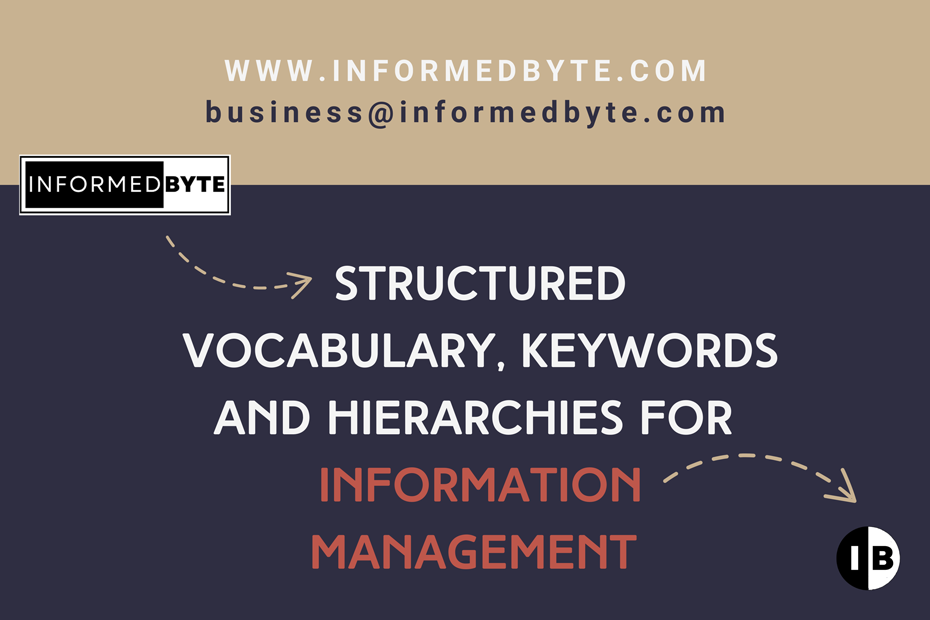Structured Vocabulary, Keywords and Hierarchies for Information Management
March 11, 2025
At Informed Byte, we think structured vocabulary, keywords, and hierarchies for information management is fascinating. You and your team might not…..that is why we are here, to provide expertise and experience for information management, so you don't have to learn about it.

Image made by Copilot
In today's digital age, managing information effectively is crucial. Whether you're dealing with a vast library of documents, a database of customer information, or a collection of research papers, having a structured approach to organising this information can make a world of difference. This is where structured vocabulary, keywords, and hierarchies come into play.
What is Structured Vocabulary?
Structured vocabulary refers to a controlled set of terms and phrases used to describe and categorise information. Unlike free-text descriptions, which can vary widely in wording and interpretation, structured vocabulary ensures consistency and accuracy. This is particularly important in fields like library science, data management, and information retrieval.
The Role of Keywords
Keywords are specific terms or phrases that capture the essence of a piece of information. They are often used in search engines and databases to help users find relevant information quickly. In the context of information management, keywords can be thought of as the building blocks of structured vocabulary.
When choosing keywords, it's important to consider the terms that users are likely to search for. This requires a good understanding of the subject matter and the needs of the users.
Hierarchies in Information Management
Hierarchies are another crucial component of information management. They involve organising information into a structured format, often in the form of a tree or pyramid. This allows users to navigate through the information in a logical and intuitive way.
Benefits of Structured Vocabulary, Keywords, and Hierarchies
Using structured vocabulary, keywords, and hierarchies offers several benefits:
Improved Searchability: With a consistent set of terms and a logical structure, users can find information more easily and quickly.
Enhanced Accuracy: Structured vocabulary reduces ambiguity and ensures that information is categorised correctly.
Better Organisation: Hierarchies provide a clear and intuitive way to navigate through information, making it easier to manage large datasets.
Consistency: Using a controlled set of terms ensures that everyone in an organisation is on the same page, reducing confusion and errors.
Implementing Structured Vocabulary, Keywords, and Hierarchies
Implementing these concepts in your information management system requires careful planning and consideration. Here are some steps to get started:
Identify Key Concepts: Start by identifying the key concepts and terms relevant to your information. This might involve consulting with subject matter experts or conducting a thorough review of your existing data.
Develop a Controlled Vocabulary: Create a controlled vocabulary that includes all the relevant terms and phrases. This should be a living document that can be updated as new terms emerge.
Assign Keywords: Assign keywords to each piece of information in your system. This might involve tagging documents, creating metadata, or using automated tools to extract keywords.
Create a Hierarchical Structure: Organise your information into a hierarchical structure that makes sense for your users. This might involve creating categories and subcategories or using a more complex tree structure.
Test and Refine: Once you've implemented your structured vocabulary, keywords, and hierarchies, test them with real users to see how well they work. Gather feedback and make any necessary adjustments.
Challenges and Considerations
While the benefits of structured vocabulary, keywords, and hierarchies are clear, there are also some challenges to consider:
Maintenance: Keeping your controlled vocabulary and hierarchical structure up to date can be time-consuming. It's important to have a process in place for regularly reviewing and updating these elements.
User Adoption: Getting users to adopt and consistently use the structured vocabulary and keywords can be challenging. Training and clear documentation can help with this.
Complexity: In some cases, the information you're managing might be too complex to fit neatly into a hierarchical structure. In these cases, you might need to use a combination of hierarchies and other organisational methods, such as tagging or linking related information.
How Informed Byte can help
We can do a little (like consulting) or a lot (like full design and implementation).
Whether you're managing a library, a database, or a collection of research papers, structured vocabulary, keywords, and hierarchies are powerful tools for managing information. By providing a consistent and logical framework for organising information, they make it easier for your stakeholders to find what they need and ensure that information is categorised accurately.
Let's start by identifying your key concepts, developing a controlled vocabulary, and creating a hierarchical structure that makes sense for the context of your business.
Let's get started
